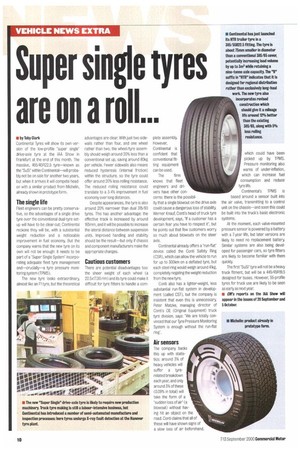Super single tyres are on a roll...
Page 12

If you've noticed an error in this article please click here to report it so we can fix it.
• by Toby Clark Continental Tyres will show its own version of the low-profile "super single' drive-axle tyre at the IAA Show in Frankfurt at the end of this month. The massive, 495/45R22.5 tyre—known as the "SuSi" within Continental—will probably not be on sale for another two years, but when it arrives it MI compete headon with a similar product from Michelin, already shown in prototype form.
The single life Fleet engineers can be pretty conservative, so the advantages of a single drive tyre over the conventional dual-tyre setup will have to be clear-cut; Continental reckons they will be, with a substantial weight reduction and a noticeable rriprovement in fuel economy But the company warns that the new tyre on its own will not be enough: it needs to be part of a ''Super Single System'. incorporating adequate fleet tyre management and—crucially—a tyre pressure monitoring system (TPMS).
The new tyre looks extraordinary, almost like an Fl tyre, but the theoretical advantages are clear. With just two sidewalls rather than four, and one wheel rather than two, the wheel/tyre assembly should weigh around 20% less than a conventional set up, saving around 80kg per vehicle. Fewer sidewalls also means reduced hysteresis (internal friction) within the structure, so the tyre could offer around 20% less rolling resistance. The reduced rolling resistance could translate to a 3-4% improvement in fuel economy over long distances.
Despite appearances, the tyre is also around 20% narrower than dual 315/80 tyres. This has another advantage: the effective track is increased by around 165mm, and it will be possible to increase the lateral distance between suspension units. Improved handling and stability should be the result—but only if chassis and component manufacturers make the appropriate changes.
Cautious customers
There are potential disadvantages too: the sheer weight of each wheel (a 22.5x17.00 rim) and its tyre could make it difficult for tyre fitters to handle a corn plete assembly However, Continental is confident that conventional fitting equipment can be used.
The firm knows that fleet engineers and drivers have other concerns: there is the possibil ity that a single blowout on the drive axle could cause a dangerous loss of stability. Werner Knauf, Conti's head of truck tyre development, says, if a customer has a certain fear you have to respect it", but he points out that few customers worry so much about blowouts on the steer axle.
Continental already offers a "run-flat' device called the Conti Safety Ring (CSR), which can allow the vehicle to run for up to 300km on a deflated tyre, but each steel ring would weigh around 41kg, completely negating the weight reduction from the new tyre.
Conti also has a lighter-weight, less substantial run-flat system in development (called CST), but the company is insistent that even this is unnecessary Peter Matzke, managing director of Conti's OE (Original Equipment) truck tyre division, says: "We are totally convinced that our Tyre Pressure Monitoring System is enough without the run-flat ring".
Air sensors
The company backs this up with statistics: around 3% of heavy vehicles will suffer a tyrerelated breakdown each year, and only around 3% of these (0.09% in total) will take the form of a "sudden loss of air" (a blowout) without having hit an object on the road. Conti claims that all of these will have shown signs of a slow loss of air beforehand, which could have been picked up by TPMS. Pressure monitoring also warns of under-inflation, which can increase fuel consumption and reduce tyre life.
Continental's TPMS is based around a sensor built into the air valve, transmitting to a control unit on the chassis—and soon this could be built into the truck's basic electronic systems.
At the moment, each valve-mounted pressure sensor is powered by a battery with a 7-year life, but later versions are likely to need no replacement battery Similar systems are also being developed for passenger cars, so tyre fitters are likely to become familiar with them quickly.
The first "SuSi" tyre will not be a heavy truck fitment, but will be a 445/45R19.5 designed for buses. However, 55-profile tyres for truck use are likely to be seen as early as next year.
• CM'S reports on the IAA Show will appear in the issues of 28 September and 5 October.
















































































































